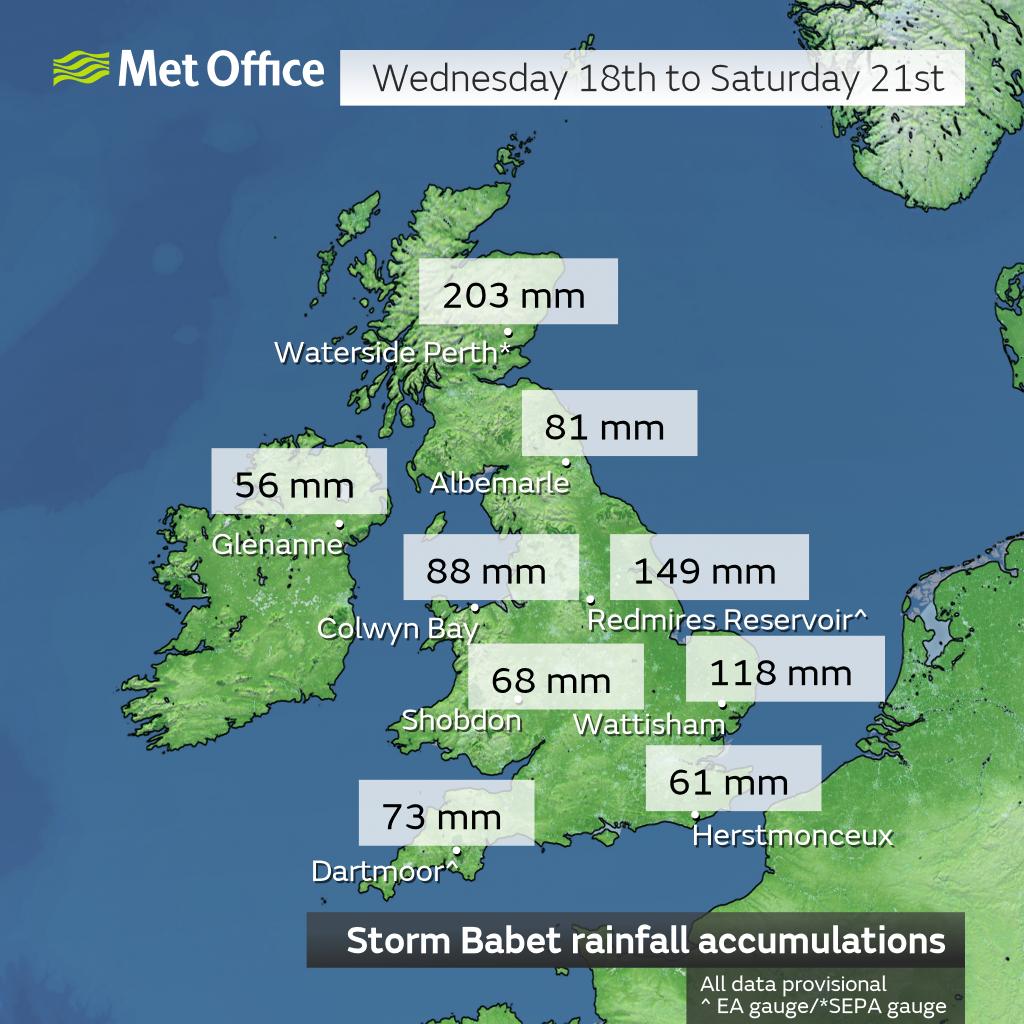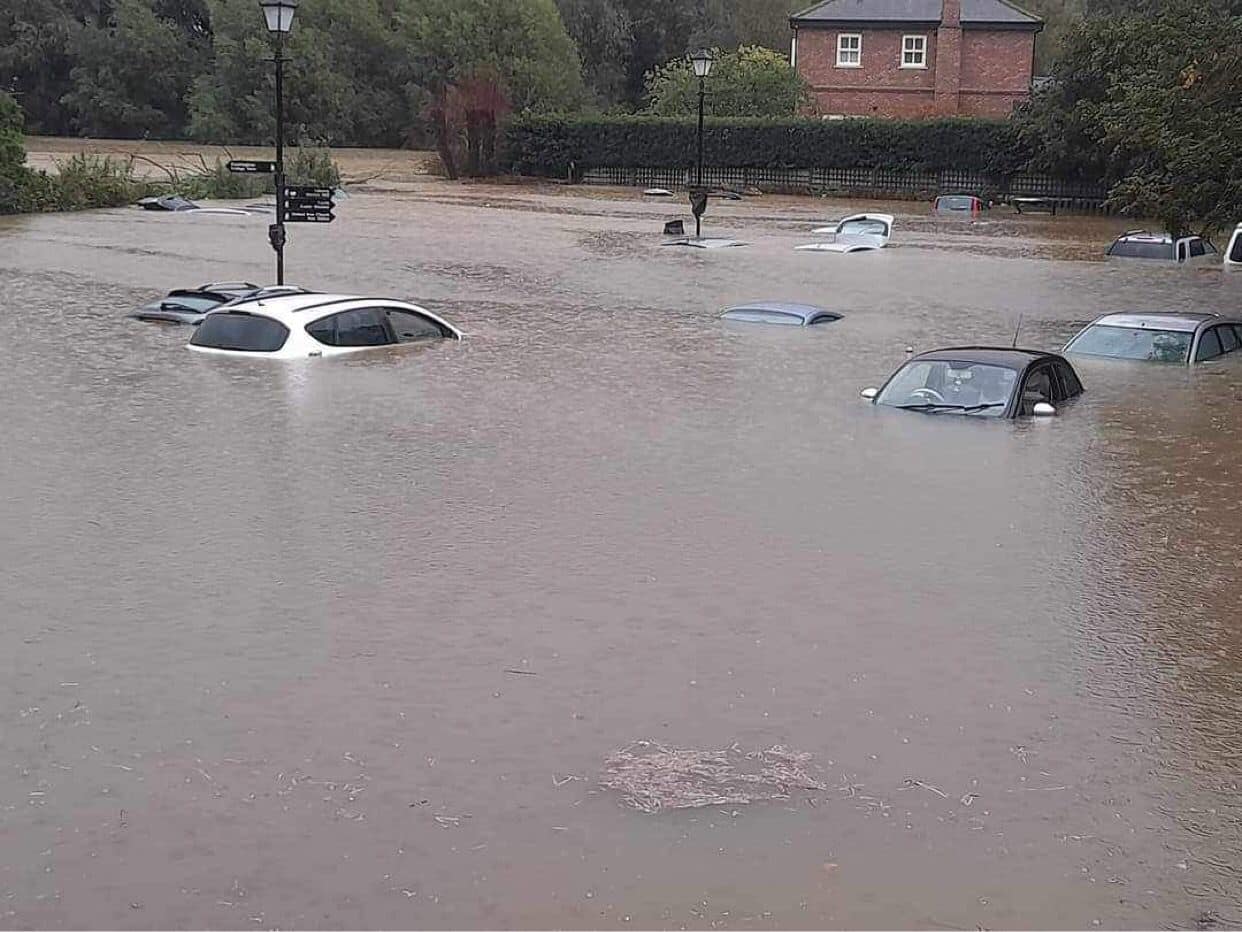Parts of the United Kingdom continue to grapple with widespread flooding stemming from the passage of Storm Babet.
Authorities have confirmed a grim toll of at least four fatalities linked to the storm that has swept the nation in recent days. Hundreds of people have evacuated their homes in parts of Scotland and central and northern England. Previously flooding from the storm caused major damages in southwest Ireland.
The UK’s Met Office said Storm Babet brought a period of very heavy rainfall to many areas of the UK. Some locations recorded well over their average October rainfall in just a few days.

Heavy rain from Storm Babet, falling on ground previously saturated from an earlier storm, caused flooding in parts of Scotland from 19 October 2023. The residents of hundreds of homes were told to evacuate in Brechin, Tannadice and Finavon in western Scotland, following warnings for flooding along the South Esk and North Esk Rivers.
Police reported one person died after being swept into the Water of Lee in Glen Esk. A second person was confirmed to have been killed after a falling tree hit a van near Forfar. Rescue services were searching for a man reportedly trapped in a vehicle caught in flood water near Marykirk in Aberdeenshire. Homes were also evacuated in Peterculter, Aberdeen.
Parts of Scotland previously saw flooding and landslides after heavy rain on 07 October 2023. Ten people were airlifted from their vehicles by a coastguard helicopter after flooding and landslides closed roads near Inveraray.
As of late 08 October levels of the Tay in Perth were extremely high and the Dee and Spey Rivers both broke their banks. On 09 October one person was reported missing and later found dead in floods near the Tay River near Strathtay.
In England, the counties of Derbyshire, Nottinghamshire and Suffolk declared major incidents in response to the extensive flooding from Storm Babet.
In an update of 23 October, the Environment Agency (EA) said the total number of properties reported to have been flooded stands at 1,260. Environment Agency teams are out on the ground working in affected areas. Temporary defences, including pumps and barriers, have been deployed to minimise the impact of flooding where needed. Flood gates have also been closed in affected areas. An estimated 41,000 properties have been protected as part of the Environment Agency’s response. The EA’s flood warning service has sent out over 300,000 messages by email, telephone and text during Storm Babet.
The EA said teams are still responding to severe flooding in the Derbyshire and Nottinghamshire catchments, where some rivers have exceeded their previous highest levels from 2007. Derby City Council said the River Derwent saw record-breaking water levels over the weekend.
Sarah Cook, flood duty manager at the Environment Agency, said, “More rain is expected, especially in the Nottinghamshire region falling on to saturated ground, meaning there is a risk of continued high levels on rivers such as the Trent and River Idle. Further significant river flooding is possible but not expected to continue into Wednesday.”
Fire and Rescue service rescued or evacuated people from homes in Sandiacre, Long Eaton and Stapleford near Nottingham and in areas of Chesterfield where an elderly person tragically died trapped in a flooded house. The local Member of Parliament, Toby Perkins, said 400 homes in his Chesterfield constituency were flooded.
Authorities urged residents of around 500 homes to evacuate after rising levels of the River Idle in Nottinghamshire threatened to flood areas of West Retford, Ordsal, Retford, Eaton and Gamston. The River Idle reached record levels of 1.79 metres in Ordsal on 22 October. The previous record high was 1.65 metres set in June 2007.
In the county of Lincolnshire, Fire and Rescue Service said 170 homes and businesses have been flooded in recent days, mostly in areas of Lincoln, Horncastle, Tattershall, Woodhall Spa, Wainfleet and Kirkby on Bain. Around 40 people evacuated their homes in Wainfleet. The River Steeping reached a record high of 2.22 metres on 21 October. The previous high was 2.12 metres set in June 2007.
Suffolk county declared a major incident due to flooding, asking people not to travel unless “absolutely essential”. Areas most badly hit by the floods were towns and villages in Babergh and Mid Suffolk districts.
In the West Midlands of England, authorities in Worcestershire and Shropshire are preparing for flooding along the along the River Severn in the coming days. One person died after getting caught in flood water in Cleobury Mortimer in Shropshire on 20 October.
Areas in the county of Yorkshire have also been affected. Around 250 homes were evacuated in Catcliffe near Rotherham where the River Rother reached record levels of 30.52 metres on 21 October. The previous high was 30.37 metres set in June 2007.
“Our heartfelt sympathies and condolences are with those who have lost loved ones in Storm Babet as well as those who are experiencing the devastating impact of having their homes and businesses flooded,” Sarah Cook, flood duty manager at the Environment Agency, said.

Previously Storm Babet caused major flooding and damages in parts of southwestern Ireland.
Flood barriers were erected across Cork, Kerry and Waterford as Storm Babet started to sweep across the country on 18 October 2023. As of early 18 October, some roads were flooded in County Cork, including in Cobh, Glanmire, Killeagh and Midleton where 100 properties were flooded. Defence Force teams were deployed to Midleton to assist flood victims. County Cork Council also reported the flooding of properties in Whitegate, Rathcormac, Glandore, Ringaskiddy, Carrigaline, Raffeen, Halfway and Castletownbere. Roads were flooded in Castlemartyr after the Kiltha river burst its banks.
The local government in County Waterford reported flooded roads in western parts of the county including Ticknock, Ballinameela and Aglish.